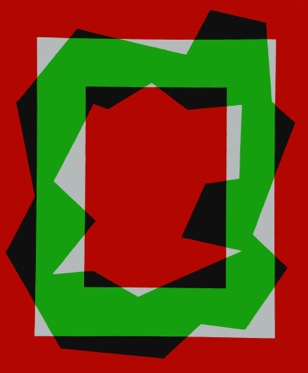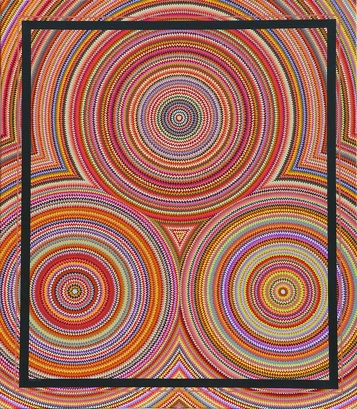Meta-art: the only avant-garde left



The small region of West Frisia in the northwest part of Holland has always been known for its stubborn inhabitants. Already in the Middle Ages a count of Holland built a number of forced castles in West Frisia to keep a close eye on its inhabitants. Marianne Schuit, although born and raised in the outskirts of Amsterdam, was the child of genuine West Frisians, who moved to Amsterdam for economic reasons.
Marianne Schuit, Meta-artist by fate, must be the most stubborn creative mind of the last 60 years. There is nothing in the arts, absolutely nothing, her art is not essentially different from. Moreover, Meta-art is the absolute antipode of the mainstream development in the arts of the 20th and early 21st century, in which the idea is seen as the alpha and omega of what can come up in the artist’s mind.
In Meta-art the idea is of no importance whatsoever. Meta-paintings come into existence through an all-intuitive process in which there is hardly any consideration of how things have to be done. Meta-art does not try, in any way, to express a certain idea. Meta-art expresses an awareness, an awareness even the Meta-artist herself does not really understand. Where 20th and early 21st century art is largely intellectually motivated, Meta-art is non-intellectual.
Does this mean that Meta-art is not involved in what is happening in our world? On the contrary, on a much deeper level than in the intellectual art surrounding it, Meta-art does damn well ‘know’ what is happening. A brand new Meta-painting like Into the wild (2013) expresses an overall uncertainty we can link to the overall uncertainty that, thanks to the economical crisis, made its way into the world for the last 4 years.
On a very profound level Meta-artist Marianne Schuit knows extremely well what is going on in our world and especially what is essential in what is happening. Not susceptive to the-idea-of-the-day, but to what is hidden behind it in the human mind, her Meta-paintings dig much deeper in the motivations of this mind than the idea-art of such artists like Ai Wei Wei, Yayoi Kusama, Cindy Sherman or Luc Tuymans. The art of these artists, no matter how different it may be, is connected by the notion that the idea behind it is the highest of the highest.
The Meta-paintings of Marianne Schuit say: an idea is too personal, too temporary, to be of great worth. An idea functions under certain circumstances to confirm that we understand the world better than other people. But it is a shallow kind of understanding, only considering the most easy to recognize phenomena connected to the human condition. Meta-art dives into the hardest to understand parts of the human condition, to reveal them with the greatest of clarities.
Madness is putting dots on everything. That’s easy to see. But it does not at all reveal the inside of madness. Society is a collection of pretty similar sunflower seeds. That’s easy to understand. But it does not reveal the much more complex sides of society, making it almost unpredictable what will happen in the future of society. Women can be found in all kinds of roles. That’s easy to recognize. The ugliness of the state of mind of people put in powerful positions, painted in bleak colours, is, well, not really hard to understand.
Ever since Marcel Duchamp put his Fountain in the midst of the art attention, the idea that the idea is the most important ‘part’ of a work of art, has spread throughout the art world like a highly contagious disease. The ideas of Marcel Duchamp were fresh, because they were new. Daring, because they were the first ones. Tickling, because they still forced you to take a stance. Almost 100 years after Fountain no idea in the arts bears the same fresh, daring and tickling qualities anymore. It has all become - as to be expected - pretty worn out. The art-ideas of today have become part of a lukewarm constellation of art-conventions.
When Marianne Schuit for the first time saw art (see: The story of Meta-art: not at all a sentimental journey link ), she already felt that this would be the case. She felt that there had to be some other artistic expression taking the possibillities of art much further than would ever be possible in idea-art. Idea-art would never be able to dig into the complexity of the human mind deeply enough to be able to reveal even the beginnings of this complexity. It would always be dependent on a quite easy to understand expression.
Being aware of the fact that you are, obviously, the only one having these kind of ideas, it takes a stubborness of Olympic size to go on your way into something that will be essentially different from everything else that is made around you. Despite the fact that you are still utterly uncertain about how this something should look like, you have to be utterly certain of the thought that it has to be somewhere hidden in the possibillities of your mind.
And it was. After years of loosely, intuitive exploration, Meta-art reveals itself to Marianne Schuit (see: The story of Meta-art: not at all a sentimental journey link ). The human mind had found its most refined, profound and comprehensive expression. The first and only expression entirely living up to the holistic qualities of this mind.
In idea-art there is this strong notion that the human mind is a pretty one-dimensional phenomenon. It is either sexual or weird or agressive or alienated or possessed or uncertain and so on and so on. The best idea-artists - like the ones above mentioned - are able to take some of these qualities together in their art, to make this art a little less one-dimensional. But still, compared to what the real human mind represents, their expressions are ‘miracles of simplicity’. Looking at their art, one might conclude that the human mind is quite understandable. And that, to put it mildly, is a sweet lie.
Contemporary artists are very talkative. They are extremely good in selling their ideas about the functioning of the human mind. But the clouds of words they produce hide a contradiction: however there is a lot to say about it, it is impossible to be talkative about the truly extremely complex nature of the human mind. People like Kafka and Wittgenstein were - outside the arts, but still... - not at all talkative, if it came to speaking about the qualities of the human mind. They painstakingly tried to formulate some words that might say something of worth about the functioning of this mind.
Marianne Schuit can be seen as a Kafka, a Wittgenstein, in the arts. Not at all talkative, her Meta-art comes closer to the true nature of the human mind than any other art.
With Olympic stubbornness, she ignored all other kinds of expression in the arts, to find the one expression that enabled her to clearly reveal the paradoxical holistic nature of our mind. And while all other art is, one way or the other, being part of the constellation of contemporary art-conventions - in which anything goes -, in fact her Meta-art is the only genuine avant-garde art left. Marianne Schuit, incredible as it may seem, is a kind of Marcel Duchamp of our day and age. A Meta-Marcel Duchamp to be more precise, because her flight goes much higher than his and because she is more unique.
Not at all understood from the contemporary art-conventions - like all truly new expressions... -, Meta-art brings tantalizing freshness, boldness and uncertainty to an art world biting its own tail for a long time already. To those who are able to see this, Meta-art opens unexpected artistic windows. But not if you are a prisoner of the idea that the idea is the highest of the highest in the arts.
Idea-art has led the arts far away from its front-runner position they once shared with the sciences. But while in the sciences our views of the world are still deepened day by day, in the arts there is only a touching of the surface of our world left, sometimes a little deeper, most of the time just this surface.
Meta-art is the extremely solitary avant-garde movement still keeping up with the profound findings of the contemporary sciences. In this it is the only art form still finding itself in the front-runner position above mentioned.
He who wants to know how incredibly far the arts have brought us, will have to take a look at Meta-art.


